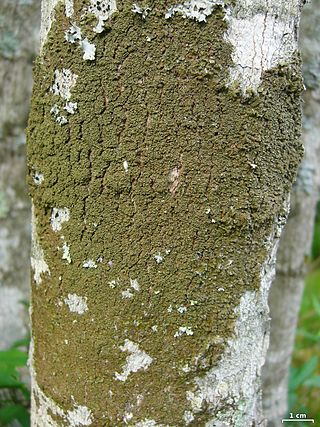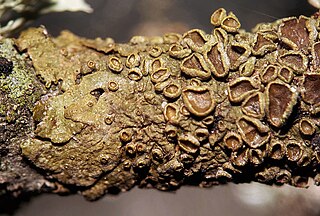
Parmelia is a genus of medium to large foliose lichens. It has a global distribution, extending from the Arctic to the Antarctic continent but concentrated in temperate regions. There are about 40 species in Parmelia. In recent decades, the once large genus Parmelia has been divided into a number of smaller genera according to thallus morphology and phylogenetic relatedness.

The Parmeliaceae is a large and diverse family of Lecanoromycetes. With over 2700 species in 71 genera, it is the largest family of lichen-forming fungi. The most speciose genera in the family are the well-known groups: Xanthoparmelia, Usnea, Parmotrema, and Hypotrachyna.

Melanohalea is a genus of foliose lichens in the family Parmeliaceae. It contains 30 mostly Northern Hemisphere species that grow on bark or on wood. The genus is characterized by the presence of pseudocyphellae, usually on warts or on the tips of isidia, a non-pored epicortex and a medulla containing depsidones or lacking secondary compounds. Melanohalea was circumscribed in 2004 as a segregate of the morphologically similar genus Melanelia.

Parmotrema is a genus of lichen belonging to the family Parmeliaceae. It is a large genus, containing an estimated 300 species, with a centre of diversity in subtropical regions of South America and the Pacific Islands.
Oropogon is a genus of lichenised ascomycetes in the large family Parmeliaceae. It is a genus of roughly 40 currently accepted species. It was previously included in the family Alectoriaceae, but this group has since been subsumed into the Parmeliaceae.

Tuckermanella is a genus of lichen-forming fungi in the family Parmeliaceae.

Esslingeriana is a fungal genus in the family Parmeliaceae. The genus is monotypic, containing the single foliose lichen species Esslingeriana idahoensis, commonly known as the tinted rag lichen. It is found in northwestern North America.
Emodomelanelia is a lichen genus in the family Parmeliaceae. It is monotypic, containing the single foliose Himalayan species Emodomelanelia masonii.
Austromelanelixia is a genus of five species of foliose lichens in the family Parmeliaceae. All species are found in the Southern Hemisphere.
John Alan (Jack) Elix emeritus professor in chemistry at the Australian National University, is an organic chemist who has contributed in many fields: lichenology, lichen chemotaxonomy, plant physiology and biodiversity and natural product chemistry. He has authored 2282 species names, and 67 genera in the field of mycology.
Melanohalea zopheroa is a species of lichen in the family Parmeliaceae. It was first formally described in 1977 by Ted Esslinger as Parmelia zopheroa. A year later, he transferred it to the new genus Melanelia, which he created to contain the brown Parmeliae species. In 2004, after early molecular phylogenetic evidence showed that Melanelia was not monophyletic, Melanohalea was circumscribed by lichenologists Oscar Blanco, Ana Crespo, Pradeep K. Divakar, Esslinger, David L. Hawksworth and H. Thorsten Lumbsch, and M. zopheroa was transferred to it. The lichen has a disjunct distribution, as it is found in South America (Chile) and in New Zealand.
Melanohalea ushuaiensis is a species of lichen in the family Parmeliaceae. It was first formally described in 1917 by Alexander Zahlbruckner as Parmelia ushuaiensis. Ted Esslinger transferred to the new genus Melanelia in 1978, which he circumscribed to contain the brown parmeliae species. In 2004, it was moved to the newly created genus Melanohalea. It is endemic to South America.
Melanohalea trabeculata is a species of foliose lichen in the family Parmeliaceae. It was first formally described by Finnish lichenologist Teuvo Ahti in 1966 as Parmelia trabeculata. Ted Esslinger transferred the species to the new genus Melanelia in 1978, which he circumscribed to contain the brown parmeliae species. In 2004, it was moved to the newly circumscribed genus Melanohalea.
Melanohalea subverruculifera is a species of lichen in the family Parmeliaceae. Found in China, it was first formally described as a new species in 1980 as Parmelia subverruculifera. It was transferred to the segregate genus Melanelia in 1991, and then to the genus Melanohalea in 2004.

Melanohalea subolivacea, commonly known as the brown-eyed camouflage lichen, is a species of foliose lichen in the family Parmeliaceae.

Melanohalea subelegantula is a species of lichen in the family Parmeliaceae. It is found in North America, where it grows on bark and wood. The lichen was first formally described as Parmelia subelegantula by Ted Esslinger in 1977. A year later he transferred it to the segregate genus Melanelia. In 2004, it was moved to the newly circumscribed genus Melanohalea. Named for its resemblance to Melanohalea elegantula, it can be distinguished from that species by its slightly flattened, but not hollow, isidia.

Melanohalea elegantula, commonly known as the elegant camouflage lichen, is a species of lichen in the family Parmeliaceae. It was first described by Alexander Zahlbruckner in 1894 as Parmelia aspidota var. elegantula. Hungarian lichenologist Ödön Szatala promoted it to full species status, as Parmelia elegantula, in 1930. Ted Esslinger transferred it to the genus Melanelia in 1978. Finally, it was assigned to the newly circumscribed genus Melanohalea in 2004.

Xanthoparmelia loxodes is a species of foliose lichen in the family Parmeliaceae. It was first formally described by Finnish botanist William Nylander in 1872, as Parmelia loxodes. In 1978, Ted Esslinger created the genus Neofuscelia, which contained species previously classified in Parmelia subgenus Neofusca; Neofuscelia loxodes was one of many species transferred here. In a 2004 molecular phylogenetic study published by Oscar Blanco, Ana Crespo, John A. Elix, David L. Hawksworth and H. Thorsten Lumbsch, they showed that Neofuscelia did not form a clade distinct from Xanthoparmelia, and they reduced it to synonymy under Xanthoparmelia.
Parmelia ambra is a fossilised species of foliose lichen in the family Parmeliaceae. Found in Dominican amber and described as a new species in 2000, the fossil has been used in subsequent studies of lichen evolution.
Melanelixia ahtii is a species of foliose lichen in the family Parmeliaceae. Found in the United States, it was formally described as a new species in 2016 by Theodore Lee Esslinger, Ana Crespo, Helge Thorsten Lumbsch, Pradeep Kumar Divakar, and Steven Leavitt. The type specimen was collected from the north side of the Columbia River Gorge. Here, at an altitude of 75 m (246 ft) above sea level, it was found in a mixed oak-ponderosa pine forest, growing as an epiphyte on an oak. The species is known from DNA-verified collections in four western US states: California, Idaho, Oregon, and Washington. The species epithet ahtii honours Finnish lichenologist Teuvo Ahti, "for his contributions to understanding diversity in brown parmelioid lichens".











